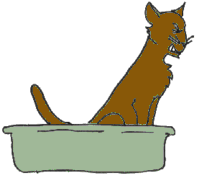
Illustration courtesy of Wendy Brooks, DVM
The diseased lower urinary tract yields the same symptoms regardless of the cause.
- Bloody urine
- Straining to urinate (can easily be mistaken for straining to defecate)
- Urinating in unusual places
- Urinary blockage (almost exclusively a male cat problem)
- Licking the urinary opening (usually due to pain)
A cat with lower urinary tract disease may have some or even all of these signs.
The Trick is Determining the Cause
The urinary bladder, urethra, and urinary opening all constitute the lower urinary tract. Effective treatment requires knowing the cause of the signs. The problem is that just about any inflammatory condition in the feline lower urinary tract creates the same collection of signs. Tumors, infections, bladder stones, etc., all create the same clinical picture.
What Are the Possible Causes?
It turns out that the cat's age is tremendously relevant in terms of which underlying causes are most likely. If we look at all cats with signs of lower urinary tract disease, we find:
- 50% will not have a cause that can be determined despite extensive testing (meaning they have what is called idiopathic cystitis).
- 20% will have bladder stones (females have a slightly higher incidence).
- 20% will have a urethral blockage.
- 1-5% will have a true urinary tract infection.
- 1-5% will have urinary tract cancer.
- 1-5% will have had trauma to the urinary tract (i.e., have been hit by a car, etc.).
- 1-5% will have a combination of a bladder stone and an infection.
- The average age for symptoms is 4 years.
If we separate the cats that are 10 years of age or older and only look at them, a different statistical picture emerges:
- 50% will have true urinary tract infections.
- 10% will have bladder stones.
- 17% will have a combination of infection and bladder stone.
- 7% will have a urethral blockage.
- 3% will have urinary tract cancer.
- Despite extensive testing, 5% will not have a cause that can be determined.
- 66% will be in some stage of insufficient kidney function.
- 5% will have urinary incontinence.
Sorting Out Causes
Testing is used to help sort patients into the correct group. A urinalysis is commonly performed. With a 50 percent incidence of infection in older cats, a urine culture would be extremely important for a cat age 10 or more, but not as important for younger cats, where the infection is rare. In younger cats, a urinalysis is helpful to look for the typical blood and crystals of idiopathic cystitis or to pick up the occasional bladder infection.
Radiographs (in cats of all ages) to rule out bladder stones are a good idea, as stones will go undetected if imaging is not considered. Ultrasound is gaining popularity and can help screen for tumors and bladder stones.
Notice the large percentage of young adult cats for whom no clear underlying cause can be identified. For these cats, there are many theories on how to proceed.
This syndrome has many causes. Use the links to guide you to other resources in these areas:
It is critical to note that lower urinary symptoms in a male cat can indicate a urinary blockage, which is an emergency situation.
If unsure if your cat can express urine, assume it could be an emergency and call your veterinarian’s office immediately.
See more about prevention.
FLUTD is a complex disease, so knowing its cause guides treatment. In other words, there is no common treatment or management. Your veterinarian is your best source of information, as they know you and your cat's circumstances.